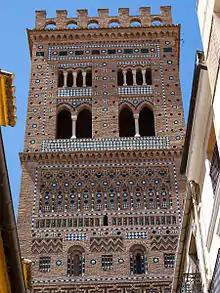穆德哈尔
穆德哈尔(Mudéjar)指的是西班牙复国运动之后未曾离开该国但也未改信的安达卢斯穆斯林。此外这个也可以指结合了穆斯林和基督教建筑风格的穆德哈尔建筑,这是12世纪开始伊比利亚半岛的主流建筑风格,其影响力延续到17世纪。[1][2]

阿拉贡的穆德哈尔式塔
各地的发展情况
参考来源
- . Arteguias. September 2012 [14 February 2016]. (原始内容存档于2016-02-05) (西班牙语).
- . 联合国教育、科学及文化组织. [14 February 2016]. (原始内容存档于2017-07-11).
- . UNESCO. [14 February 2016]. (原始内容存档于2017-07-11).
- Puig, Francisco Prat. . Biblioteca Nacional José Marti. 1947.
参考书目
- Boswell, John (1978). Royal Treasure: Muslim Communities Under the Crown of Aragon in the Fourteenth Century. Yale University Press. ISBN 0-300-02090-2
- Harvey, L. P. . University of Chicago Press. 1 November 1992 [2016-08-19]. ISBN 978-0-226-31962-9. (原始内容存档于2017-01-14).
- Harvey, L. P. . University of Chicago Press. 16 May 2005 [2016-08-19]. ISBN 978-0-226-31963-6. (原始内容存档于2017-01-13).
- Menocal, Maria Rosa (2002). "Ornament of the World: How Muslims, Jews, and Christians Created a Culture of Tolerance in Medieval Spain". Little, Brown, & Co. ISBN 0-316-16871-8
- Rubenstein, Richard (2003). "Aristotle's Children: How Christians, Muslims, and Jews Rediscovered Ancient Wisdom and Illuminated the Middle Ages." Harcourt Books. ISBN 0-15-603009-8
This article is issued from Wikipedia. The text is licensed under Creative Commons - Attribution - Sharealike. Additional terms may apply for the media files.
